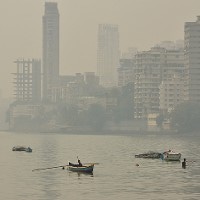Apr 1 2019
According to an autonomous study published recently by the International Institute for Applied Systems Analysis (IIASA) and the Council on Energy, Environment, and Water (CEEW), over 674 million Indian citizens are likely to breathe air with high concentrations of PM2.5 in 2030, even if India were to adhere to its current pollution control policies and protocols.
 © Roberto Maggioni|Dreamstime.com
© Roberto Maggioni|Dreamstime.com
The research reveals that just about 833 million citizens (about half of India's projected population in 2030) would be residing in areas that match India's National Ambient Air Quality Standards (NAAQS) in 2030. Failure to execute current policies and regulations could raise these numbers considerably. However, aligning sustainable development policies to the execution of advanced emission control technologies could provide NAAQS-compliant air quality to about 85% of the Indian population. The research was presented at a CEEW dialogue, On Air: Pathways to Achieving India's Ambient Air Quality Standards, held in New Delhi on March 29th.
In 2015, over half the Indian population—about 670 million citizens—were exposed to PM2.5 concentrations that did not adhere with India's NAAQS for PM2.5 (40 μg/m³). Below 1% enjoyed air quality that matched the World Health Organization (WHO) standard limit of 10 μg/m³.
A significant share of emissions still originates from sources associated with poverty and underdevelopment such as solid fuel use in households and waste management practices.
Markus Amann, Air Quality and Greenhouse Gases Program Director, IIASA.
The Indian government, in January 2019, introduced the National Clean Air Program (NCAP), a five-year action plan to control air pollution, develop a pan-India air quality monitoring network, and boost citizen awareness. The program concentrates on 102 polluted Indian cities and aims to lower PM2.5 levels by 20-30% over the following five years. The examination conducted by scientists from IIASA and CEEW, however, indicates that NCAP needs to be backed by a legal directive to guarantee effective ground-level execution of emission control measures. In the long-term, NCAP also has to be scaled-up considerably to ensure that fast economic growth and matching NAAQs are in line.
While current ambient PM2.5 monitoring in India reveals high levels in urban areas, remote sensing, comprehensive air quality modeling, and emission inventories, suggest large-scale exceedances of the NAAQS, also in rural areas. Pollution from rural areas is transported into the cities (and vice versa), where it constitutes a significant share of pollution making the coordination of urban-rural and inter-state responses critical.
Pallav Purohit, Study Lead Author and Scientist, IIASA.
The health burden of air pollution is significant in India. Limited control of air pollution will aggravate this burden in the future. The IIASA-CEEW study clearly shows that the policy choices of today will impact future air quality and its aftermaths. The central and state governments must do more to align air quality, climate change, and sustainable development goals in a resource efficient manner.
Hem Dholakia, Study Co-Author and Senior Research Associate, CEEW.
The researchers also learned that the Indo-Gangetic plain, covering parts of states such as Uttar Pradesh, Bihar, Haryana, Punjab, and West Bengal, has the maximum population exposure to substantial PM2.5 concentrations. This is mostly because of the high density of polluting sources and lesser ventilation by the hindering presence of the Himalayas. Citizens living in regions of West Bengal, Chhattisgarh, Bihar, and Odisha are also exposed to high levels of PM2.5. The governments in these states must design state-specific policies to adhere with NAAQS and accept a low-carbon growth model to guarantee improved air quality for its people.
The research also emphasized a glaring variance in factors adding to air pollution across the states. Solid fuel, including burning of biomass for residential cooking, is the chief contributor in the several states of the Indo-Gangetic Plain. However, in Goa and Delhi, it adds just a small amount because of improved access to clean fuels in these states. Instead, NOx emissions from transportation are huge contributors to air pollution in these two states. Likewise, SO2 emissions from power plants are key contributors to air pollution in Maharashtra and Haryana. In the years ahead, every state government must commission comprehensive scientific studies to properly understand the sources adding to air pollution in their cities.
“A large share of pollution can be addressed if poor households that currently use solid fuels and cash-strapped local bodies are given a helping hand,” explains Amann.
Another challenge for a number of states is that emission sources that are beyond their immediate jurisdiction add considerably to ambient pollution levels of PM2.5. For instance, crop burning or transboundary transport is a source of secondary pollution in certain states. These states could realize substantial improvements in air quality only with a state-wide coordinated method to lower air pollution and stringent on-ground enforcement to guarantee compliance with emissions control measures.
In 2015, air pollution emission control costs made up of about 0.7% of GDP. The research found that this portion will increase to 1.4–1.7% by 2030. By 2050, with nearly a tenfold increase in GDP, air pollution controls will make up for 1.1–1.5% of GDP, or 1.5% of the 2015 to 2050 increase in economic wealth (GDP).
The IIASA-CEEW study also proposes concentrating on energy efficiency, improved public transport, better agricultural production practices, increased use of cleaner fuels, and replacement of coal with natural gas and renewables in the industrial and power industries to achieve improved air quality and comply with numerous Sustainable Development Goals (SDGs).